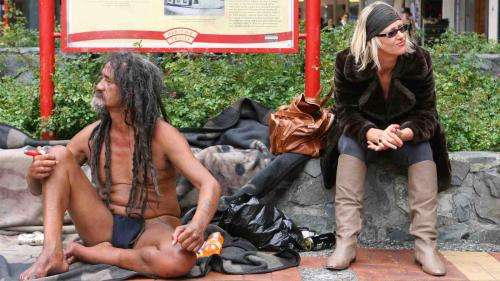In-depth sociological study of Wellington's Blanket Man

For more than three years, Victoria University of Wellington graduand Bronwyn McGovern sat with Blanket Man or Brother as the well-known homeless person was also known, as fieldwork for her thesis 'A life lived on the corner'. Brother lived on the capital's streets for a decade until his death in 2012.
"The earliest I ever started fieldwork was 4am and the latest I ever finished was 4am," says Bronwyn. "I wanted to get a sense of a whole life lived fully on the street, so that meant, for instance, sitting with Brother on Christmas Day, on the day of the Sevens tournament, on a wet Monday morning at 10am and at 7am when the commuters were going to work."
Bronwyn mapped Brother's movements and was surprised to find routine and consistency in his life. "He saw the city as his whare, positioning himself according to the weather and whether he was feeling sociable."
Living on the street 24/7 meant Brother needed to find ways of having 'down time' while living in public. According to Bronwyn, he used a variety of techniques and methods which worked to invite or shut down interaction.
"This was essential as interaction with pedestrians was constant," says Bronwyn. Once, within a 30-minute period, she observed a total of 54 people interacting with Brother in 26 separate instances.
A chapter in Bronwyn's thesis analyses Brother's use of humour.
"He could use self-deprecating humour to block people who tried to show they cared or who complimented him. This allowed him to create and maintain distance as, by not taking himself seriously, it was then difficult for others to do so."
However, she says, his sense of humour also enabled him to enjoy life, even under adverse circumstances. "One morning following a night in police custody at Wellington Central Police Station, Brother said to me, "Ah Hilton Central, just another occupational hazard that comes with the territory."
Bronwyn says on several occasions Brother told her that he did not consider himself to be homeless as the city was his home. He also claimed that his life on the street commenced as a choice.
"His street lifestyle could be understood as the longest solitary land protest ever staged in this country. Brother's street campaigning encapsulated his vision of an Aotearoa wherein the land would belong to all people."
However, she says that over time it was difficult for Brother to maintain this philosophy. "The longer that hard existence went on it took all his energy just to survive and get through each day."
Towards the end of his life, Brother was occasionally institutionalised. "I considered him to be a person of sound mind and strong disposition who simply elected to do stuff his way. He was nonetheless institutionalised and, as a consequence, he was inevitably labelled with a psychiatric condition. My thesis demonstrates how these classifications become emblematic of how society 'makes up people', and how, in Brother's case, the assigned classifications led to the 'un-making' of a person."
Bronwyn is currently working on turning her thesis into a book. "It's a way of telling Brother's story the way he would have liked it to be told."
Provided by Victoria University of Wellington



















